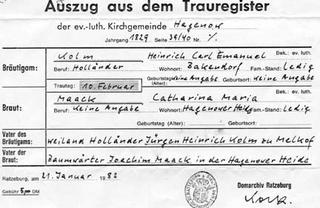Carl Kolm, Holländer
The marriage of Heinrich "Carl" Emanuel Kolm and Christine "Maria" Maack in 1829 was recorded in the Hagenow, Mecklenburg-Schwerin parish records. On that record, Carl Heinrich was described as a "Holländer". At first glance, this designation seems obvious: a Holländer is someone from Holland. That is the definition given by German-English dictionaries. Unfortunately, in this case, the translation is wrong.
Extract from the Hagenow Parish Records

An important clue is the field in which the term is entered: Beruf. A Beruf is a "occupation". It is the field labeled "Wohnort" that shows were the person is living. In this case, Carl Kolm lived in Bakendorf, a village near Hagenow.
So what occupation is a Holländer? If you look up the term in German dictionaries, particularly those with more archaic terms, you learn that a Holländer is also a term to describe a particular type of dairyman.
"östlich von der Elbe der milchwirtschafter auf einem gute, meist pächter."(definition from the Deutsches Wörterbuch von Jacob Grimm und Wilhelm Grimm)In English, that means "east of the Elbe River, the dairyman (or "milk manager") on a farm, usually tenants".
The term appears to have originated in the 1600s, when emigrants came east from Holland, initially settling in the Dutchies of Schleswig and Holstein and the marshes of the Elbe river. These "Dutchmen" introduced new techniques for processing milk. They usually leased the cows on a "Gut", being responsible for milking and selling the dairy products. As the practice spread, the term "Holländer" became associated with the dairymen themselves.
In 19th century Mecklenburg-Schwerin, a "Gut" was a large piece of land owned by a rich landlord, and farmed by "Pächter" (tenants). The way I envision a "Gut", it is closer to an "estate" than what I think of as a farm.
Translation of the extract from the marriage register:
Year: 1829 Page: 39/40 Date: 10th February
Groom: Kolm, Heinrich Carl Emanuel; Profession: Holländer; residence: Bakendorf; status: single
Bride: Maack, Catharina Maria; residence: Hagenower Heide; status: single
Father of the groom: deceased Holländer Jürgen Heinrich Kolm of Melkof
Father of the bride: "tree caretaker" (forester?), Joachim Maack in Hagenower Heide
LINKS
• Was ist ein Holländer? (in German, Google English Translation)
• GenWiki entry for Holländer (in German)
• Mecklenburg Rural Life Museums from the Garling Mecklenburg genealogy page (see the FAQ).
• Map of Mecklenburg showing Bakendorf
Labels: Germany, Kolm, Mecklenburg
Read the rest of this post.



